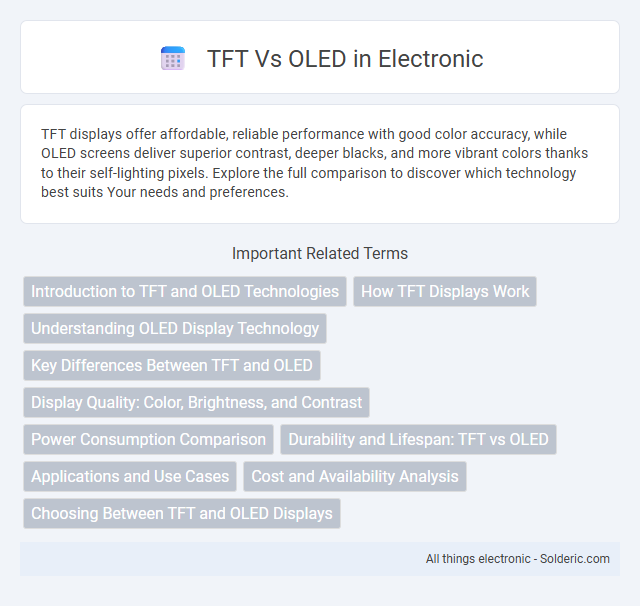TFT displays offer affordable, reliable performance with good color accuracy, while OLED screens deliver superior contrast, deeper blacks, and more vibrant colors thanks to their self-lighting pixels. Explore the full comparison to discover which technology best suits Your needs and preferences.
Comparison Table
| Feature | TFT Display | OLED Display |
|---|---|---|
| Technology | Thin-Film Transistor LCD | Organic Light Emitting Diode |
| Backlight | Required (LCD with LED) | Self-emissive (no backlight) |
| Contrast Ratio | Lower (around 1000:1) | Higher (up to 1,000,000:1) |
| Color Quality | Good but limited | Superior color accuracy and vibrance |
| Viewing Angles | Narrower viewing angles | Wide viewing angles without color shift |
| Response Time | Slower response time | Fast response time (ideal for motion) |
| Power Consumption | Higher (due to backlight) | Lower power for darker images |
| Flexibility | Rigid panels | Flexible and thin panels |
| Lifespan | Longer lifespan | Shorter lifespan (organic degradation) |
| Cost | Lower manufacturing cost | Higher manufacturing cost |
Introduction to TFT and OLED Technologies
TFT (Thin Film Transistor) technology enhances LCD displays by improving image stability and sharpness, using active matrix circuitry to control individual pixels precisely. OLED (Organic Light Emitting Diode) technology features self-emissive pixels that produce deeper blacks and higher contrast by emitting light directly without a backlight. Your choice between TFT and OLED impacts display brightness, color accuracy, and power consumption based on these fundamental architectural differences.
How TFT Displays Work
TFT displays use thin-film transistor technology to control individual pixels, enhancing image sharpness and color accuracy by providing precise voltage regulation to each pixel's liquid crystal element. This active matrix approach boosts response times and reduces crosstalk compared to passive matrix displays. Your viewing experience benefits from improved brightness and contrast as a result of the efficient pixel control inherent in TFT technology.
Understanding OLED Display Technology
OLED display technology uses organic light-emitting diodes that emit light individually, enabling deeper blacks and higher contrast ratios compared to TFT LCDs, which rely on a backlight. The self-illuminating pixels in OLED panels allow for thinner, more flexible displays with faster response times and wider viewing angles. OLED's power efficiency varies with content, often consuming less energy when displaying darker images due to the absence of a constant backlight.
Key Differences Between TFT and OLED
TFT (Thin-Film Transistor) displays rely on liquid crystals modulated by electric currents and require a backlight, resulting in lower contrast and narrower viewing angles compared to OLED (Organic Light-Emitting Diode) screens. OLED panels produce light at the pixel level, enabling true blacks, higher contrast ratios, and more vibrant colors without the need for a backlight. Power consumption in TFT displays is generally higher due to the constant backlight, while OLED provides better energy efficiency in scenes with darker content.
Display Quality: Color, Brightness, and Contrast
OLED displays offer superior color accuracy and deeper blacks compared to TFT screens due to their self-emissive pixels, which enable true black levels and higher contrast ratios. TFT LCDs rely on backlighting, resulting in lower brightness and less vibrant colors, with limited contrast performance especially in dark scenes. OLED technology also supports wider color gamuts and faster response times, enhancing overall display quality for rich visuals and vivid images.
Power Consumption Comparison
OLED displays consume less power than TFT LCDs when showing darker images due to their ability to turn off individual pixels, resulting in more energy efficiency for black or low-brightness content. Conversely, TFT LCDs generally maintain consistent power usage regardless of image brightness because their backlight remains constantly on. This difference makes OLED technology preferable for battery-powered devices when displaying predominantly dark themes or interfaces.
Durability and Lifespan: TFT vs OLED
OLED displays typically offer superior contrast and color accuracy but have a shorter lifespan due to organic material degradation, averaging around 30,000 to 50,000 hours. TFT (Thin Film Transistor) LCDs provide greater durability and longer lifespan, often exceeding 60,000 hours, making them more resistant to burn-in and environmental wear. When choosing a screen for long-term use, your decision should weigh OLED's vibrant visuals against TFT's robust durability and longevity.
Applications and Use Cases
TFT LCDs dominate in applications requiring vibrant color accuracy and cost-effective display solutions, such as computer monitors, laptops, and industrial control panels. OLED technology excels in smartphones, high-end televisions, and wearable devices due to its superior contrast ratios, flexibility, and faster response times. Each technology's use case leverages its inherent strengths: TFT for durability and affordability, OLED for vivid visuals and energy efficiency in portable and premium displays.
Cost and Availability Analysis
TFT displays generally incur lower production costs due to simpler manufacturing processes and widespread availability of raw materials, making them a budget-friendly option for many electronic devices. OLED technology, while offering superior picture quality and flexibility, involves more complex fabrication steps and expensive organic compounds, resulting in higher market prices and limited mass adoption. The supply chain for TFT panels remains robust and diverse, whereas OLED production capacity is currently concentrated among a few key manufacturers, affecting availability and pricing fluctuations.
Choosing Between TFT and OLED Displays
Choosing between TFT and OLED displays depends on your needs for brightness, color accuracy, and power consumption. TFT displays offer higher brightness levels and are generally more affordable, making them ideal for outdoor use or budget-conscious applications. OLED screens provide superior contrast, deeper blacks, and better energy efficiency during dark image display, enhancing your viewing experience in low-light environments.
TFT vs OLED Infographic

 solderic.com
solderic.com